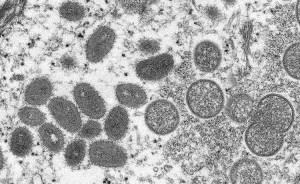What is Monkeypox?

An electron microscope shows monkeypox virus particles.
Credit: Cynthia S. Goldsmith and Russell Regnery, CDC
On May 13, 2022, the World Health Organization was notified of two confirmed cases of monkeypox in the United Kingdom. Not the chickenpox, monkeypox! Since then, cases have been detected in Canada, Italy, Portugal, Spain, Sweden, and the United States. Many people are now asking: what is monkeypox and how bad is it?
Monkeypox is a viral disease that affects animals and, in rare cases, human beings. Scientists first isolated and identified the monkeypox virus from laboratory monkeys in 1958. They obtained it from monkeys that had an unusual rash of skin pustules (small bumps filled with fluid). Historically, such pustules were called pox, leading to the name monkeypox. Other animals, including rats, squirrels, and mice, can also carry monkeypox.
People that eat or get bitten by infected animals can catch monkeypox, but the virus does not spread easily from person to person. The disease is uncommon in human beings. The first human case of monkeypox was not recorded until 1970.
Monkeypox occurs naturally among wild animal populations of central and western Africa. Since the 1970’s, it has caused occasional outbreaks of illness among people in the region. In 2003, 71 people in Illinois, Indiana, Kansas, Missouri, Ohio, and Wisconsin became ill with confirmed or suspected cases of monkeypox. They caught the disease after handling prairie dogs that were purchased at a pet shop in Illinois. Prairie dogs do not naturally carry the monkeypox virus. The animals became infected at the pet shop, where they were housed with a rodent called a Gambian giant rat that carried the virus. An animal dealer had imported the rat from Africa to sell it as a pet.
Several people were hospitalized in the 2003 outbreak, but there were no deaths. Physicians and veterinarians quickly quarantined (isolated) people and animals that might have been exposed to the virus. This action was designed to prevent the disease from spreading to other people, pets, or wild animals. Following the outbreak, the United States Centers for Disease Control and Prevention (CDC) and the Food and Drug Administration (FDA) banned the importation of rodents from Africa. They also banned the transport and sale of prairie dogs and African rodents within the United States.
Symptoms of the disease develop about two weeks after a person is exposed to the monkeypox virus. Symptoms include fever, headache, muscle pain, backache, and swelling of lymph nodes. Following the fever, a rash appears on the face and other parts of the body. The rash develops into fluid-filled pustules, which dry up and fall off. The illness lasts from two to four weeks. In Africa, from 1 percent to 10 percent of people infected with monkeypox die from the disease.
Physicians suspect monkeypox if a person shows the symptoms and has had contact with an infected person or animal. Laboratory tests are used to detect the monkeypox virus in samples from blood, pustules, or scabs of patients.
People can prevent infection by not handling wild animals that may carry the virus. The monkeypox virus is related to the virus that causes smallpox. Smallpox vaccine can protect against monkeypox when it is given before a person is exposed to the virus. Smallpox vaccination given after exposure to monkeypox may help prevent the disease or make it less severe. However, because the disease is uncommon, health officials do not recommend widespread smallpox vaccination to protect people from monkeypox.


